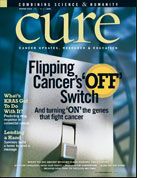Publication
Article
CURE
Chemical Reactions
Author(s):
Epigenetics may turn the field of toxicology upside down.
We live our lives in the company of chemicals, from the pollution that makes its way into our air and food, to the synthetic material in the products we use every day. These compounds are considered safe, based on tests that look for the degree of exposure necessary to trigger DNA damage. But just as epigenetics is changing the way people think about cancer, it’s starting to change the way people think about cancer causes.
“I think the field of epigenetics is going to turn the field of toxicology on its head,” says Randy Jirtle, PhD, of Duke University Medical Center. Why? Because it raises the possibility that low levels of chemicals—chemicals now considered safe—are in fact silently marking our DNA in ways that can lead to cancer.
And these pollutants might not only affect our lives, but our children and grandchildren. In 2006, scientists from Washington State University reported that mice exposed to a certain fungicide experienced epigenetic changes that were passed to future generations. Preliminary data have suggested similar connections with smoking.
At this point, little is certain, says Jirtle, who has conducted experiments with bisphenol A, a controversial chemical found in plastic bottles and canned-food liners. Experiments on bisphenol A have suggested that the compound, which is so ubiquitous it can be measured in the bodies of 93 percent of Americans, can cause epigenetic changes. But the research has been conducted in laboratory rodents, and animal epigenomes differ from humans. This is the case for most chemicals: Data on the epigenetic impact is either non-existent or limited to laboratory experiments.
The federal government is now trying to change that, with the National Institute of Environmental Health Sciences (part of the National Institutes of Health) investing almost $30 million in epigenetic studies of environmental exposures over five years. Some of the first human data from those studies may be released soon, says Fred Tyson, PhD, a scientific program director at NIEHS. The pollutants under examination include arsenic, air particulates, bio-active dietary zeranol (from injected cattle), dietary biotin, polychlorinated biphenyls (PCBs), and polycyclic aromatic hydrocarbons (byproducts of burning fossil fuels).
“It’s possible it (epigenetics) could have some policy implications for what acceptable levels of exposure are,” Tyson says, though no one can yet say what the outcome of the research will be.
Jirtle believes that, at the very least, the most common environmental pollutants need to be reexamined for safety. “It’s been assumed that since they don’t cause mutations that they aren’t problematic,” he says. “I don’t think that’s good enough.”






